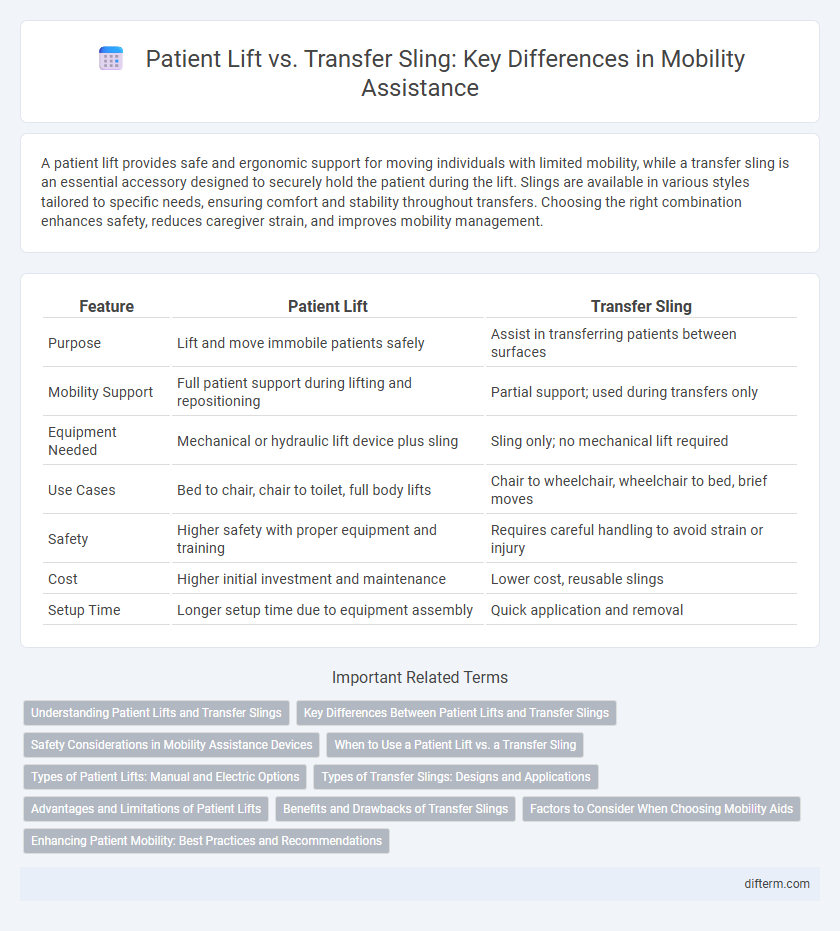A patient lift provides safe and ergonomic support for moving individuals with limited mobility, while a transfer sling is an essential accessory designed to securely hold the patient during the lift. Slings are available in various styles tailored to specific needs, ensuring comfort and stability throughout transfers. Choosing the right combination enhances safety, reduces caregiver strain, and improves mobility management.
Table of Comparison
| Feature | Patient Lift | Transfer Sling |
|---|---|---|
| Purpose | Lift and move immobile patients safely | Assist in transferring patients between surfaces |
| Mobility Support | Full patient support during lifting and repositioning | Partial support; used during transfers only |
| Equipment Needed | Mechanical or hydraulic lift device plus sling | Sling only; no mechanical lift required |
| Use Cases | Bed to chair, chair to toilet, full body lifts | Chair to wheelchair, wheelchair to bed, brief moves |
| Safety | Higher safety with proper equipment and training | Requires careful handling to avoid strain or injury |
| Cost | Higher initial investment and maintenance | Lower cost, reusable slings |
| Setup Time | Longer setup time due to equipment assembly | Quick application and removal |
Understanding Patient Lifts and Transfer Slings
Patient lifts are mechanical devices designed to safely move patients with limited mobility, reducing caregiver strain and minimizing injury risk. Transfer slings are specialized fabric supports used in conjunction with patient lifts, providing secure and comfortable positioning during transfers. Understanding the compatibility and correct usage of different sling types with specific patient lifts ensures effective and safe mobility assistance.
Key Differences Between Patient Lifts and Transfer Slings
Patient lifts are mechanical devices designed to safely lift and transport patients who have limited mobility, often featuring motorized functions and a supportive frame for stability. Transfer slings are fabric accessories used with patient lifts or by caregivers to assist in moving patients by securely wrapping around the body, providing support during the transfer process. Key differences include that patient lifts provide the lifting power and structural support, while transfer slings serve as the interface between the patient and the lift, ensuring comfort and safety during movement.
Safety Considerations in Mobility Assistance Devices
Patient lifts provide enhanced safety by reducing caregiver strain and minimizing the risk of injury through mechanical support, whereas transfer slings require precise positioning to ensure patient stability during transfers. Choosing the appropriate device depends on the patient's mobility level, weight, and balance, with lifts offering greater security for heavier or less stable individuals. Proper training and adherence to usage guidelines significantly improve safety outcomes in mobility assistance, preventing falls and pressure injuries.
When to Use a Patient Lift vs. a Transfer Sling
Patient lifts are ideal for safely moving patients who cannot support their own weight, especially during vertical transfers or repositioning in bed. Transfer slings are better suited for partial assistance, such as sliding a patient from a wheelchair to a bed or chair, allowing more control and flexibility. Choosing between a patient lift and a transfer sling depends on the patient's mobility level, physical condition, and the specific transfer task required.
Types of Patient Lifts: Manual and Electric Options
Manual patient lifts, powered by user effort, offer affordable, portable solutions for short-term mobility assistance, featuring hydraulic or mechanical lifting mechanisms. Electric patient lifts utilize battery-powered motors for smooth, effortless transfers and typically include advanced safety features and adjustable lifting capacities suitable for heavier patients. Both types accommodate various transfer slings designed to support patient comfort and security during lifting and repositioning tasks.
Types of Transfer Slings: Designs and Applications
Transfer slings come in various designs such as universal, toileting, hammock, and standing slings, each tailored to specific patient mobility needs and transfer scenarios. Universal slings provide all-around support for general transfers, while toileting slings feature open designs to facilitate hygiene care. Standing slings assist patients who can bear some weight by promoting supported standing and partial weight-bearing transfers, optimizing safety and comfort during mobility tasks.
Advantages and Limitations of Patient Lifts
Patient lifts provide safe and efficient mobility support for individuals with limited strength, reducing the risk of caregiver injury by enabling mechanical assistance during transfers. Their advantages include enhanced stability, adjustable support, and the ability to accommodate various sling types, offering versatility for different patient needs. Limitations involve higher costs, the need for proper training to ensure user safety, and potential space constraints due to the equipment's size.
Benefits and Drawbacks of Transfer Slings
Transfer slings offer significant benefits in patient mobility by providing secure support and reducing the risk of injury during transfers, allowing caregivers to move patients with greater ease and minimal physical strain. However, transfer slings may cause discomfort or skin irritation if not properly fitted, and they require specific training for safe and effective use. Choosing the right type of transfer sling, such as full-body or hammock styles, is essential to balance comfort, safety, and functionality in various patient mobility scenarios.
Factors to Consider When Choosing Mobility Aids
When choosing between a patient lift and a transfer sling, consider the patient's weight, mobility level, and medical condition to ensure safety and comfort. Evaluate the caregiver's ability to operate the equipment and the available space to accommodate the mobility aid. Durability, ease of cleaning, and compatibility with existing hoisting systems also play critical roles in selecting the appropriate device.
Enhancing Patient Mobility: Best Practices and Recommendations
Using a patient lift combined with a transfer sling significantly reduces the risk of injury while enhancing patient mobility by providing secure and ergonomic support during transfers. Selecting the appropriate lift and sling type based on patient weight, size, and mobility level optimizes safety and comfort. Regular staff training on lift operation and sling positioning improves efficiency and promotes dignity in patient movement.
patient lift vs transfer sling Infographic

 difterm.com
difterm.com